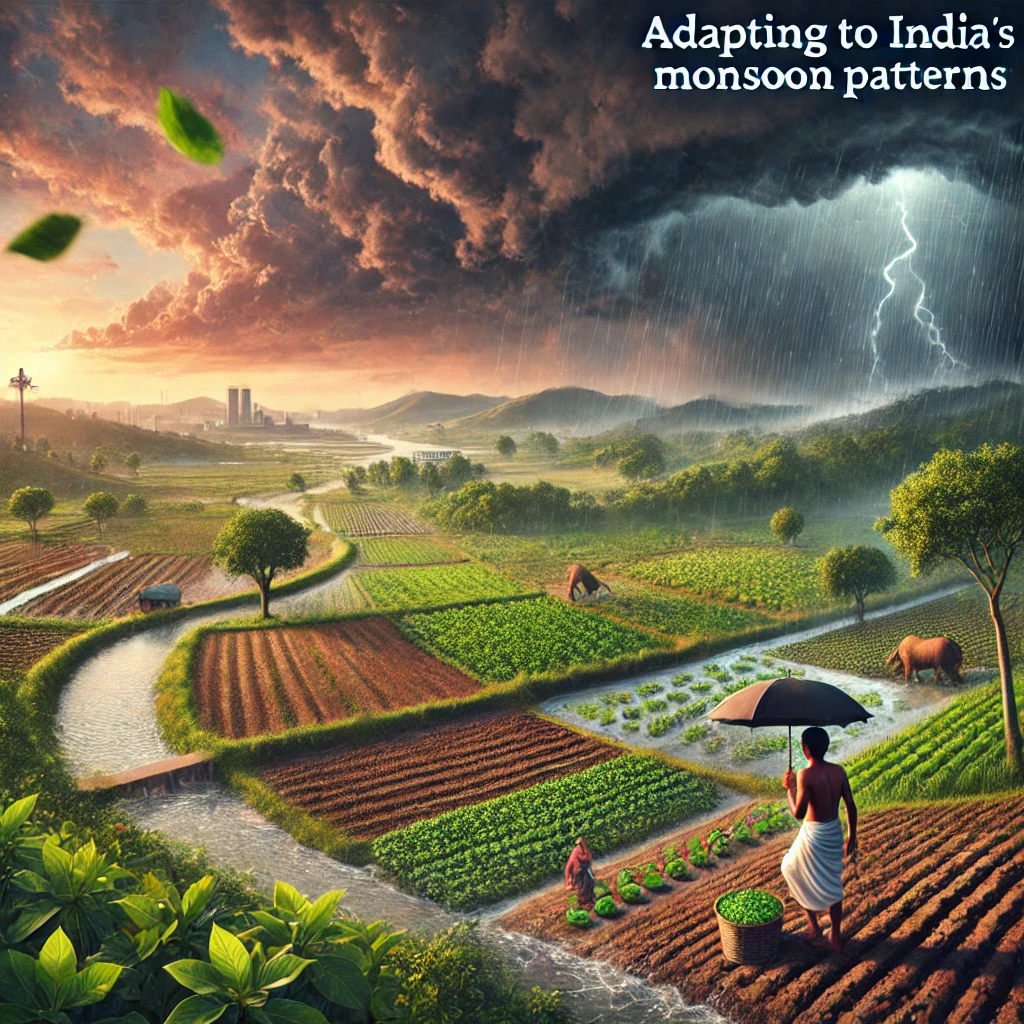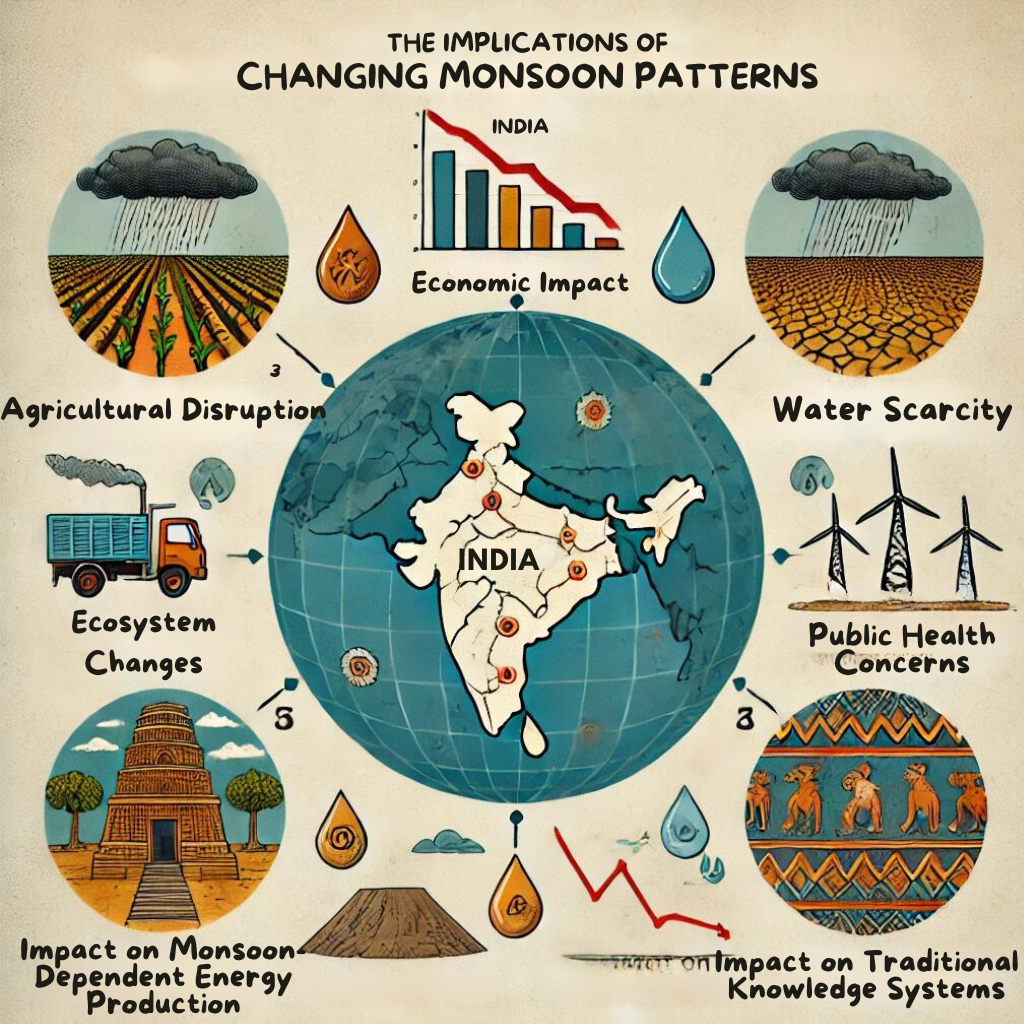India’s monsoon pattern is shifting significantly, marked by delayed onset, inconsistent rainfall, and extended rainy seasons. This year’s monsoon, arriving late and progressing slowly, highlights this trend. Factors such as delayed western disturbances and Arctic ice melting, influenced by climate change, contribute to these changes. The erratic rainfall distribution and unusual temperatures pose serious challenges for agriculture and water management across India. Immediate and long-term strategies are crucial to protect farmers from economic losses and ensure efficient water resource management.
Origin of the Article
This editorial is based on “Learning to live with shifts in monsoon” published in Hindustan Times on 25/06/2024. The article discusses the erratic monsoon patterns affecting agricultural cycles and water management due to climate change.
Relevancy for UPSC Students
Understanding shifting monsoon patterns is vital for UPSC aspirants as it intersects with topics in GS Paper 1 (Physical Geography) and GS Paper 3 (Irrigation, Water Resources). Knowledge of these changes aids in comprehending climate impacts, economic implications, and policy-making, which is essential for writing insightful answers in both prelims and mains examinations.

Why in News
The article on shifting monsoon patterns is crucial for UPSC aspirants as it directly connects with topics like climate change, water management, and agricultural resilience, frequently discussed in GS Papers 1 and 3. Understanding these dynamics is essential, given the recurring UPSC questions on the Indian monsoon and its socio-economic impacts, like those on the Indian Ocean Dipole and changing monsoon behavior.
Significance of Monsoon for India
Agricultural Backbone
The monsoon serves as the backbone of Indian agriculture, directly affecting food security and rural livelihoods. Approximately 61% of Indian farmers depend on rainfall, with 55% of India’s agricultural land being rain-fed. Major crops such as rice, wheat, and pulses rely heavily on monsoon rains, making its timely arrival crucial for agricultural productivity and the overall economic health of the nation.
Water Resource Management
India receives 70-90% of its annual rainfall during the monsoon season, which is vital for replenishing water bodies like rivers, lakes, and groundwater aquifers. This concentrated rainfall period is essential for irrigation, drinking water supply, and hydroelectric power generation. Effective water resource management during the monsoon ensures year-round water availability for various needs.
Economic Ripple Effects
Monsoon rains influence rural incomes, consumer demand, and inflation. A good monsoon boosts rural incomes, increasing the demand for consumer goods and services. Conversely, a poor monsoon can lead to inflation, especially in food prices, affecting the broader economy. The monsoon’s performance often shapes monetary policy and government spending priorities, highlighting its economic significance.
Ecological Balance
The monsoon is crucial for maintaining India’s diverse ecosystems, supporting forests, wetlands, and wildlife habitats. It influences wildlife migration patterns, breeding cycles, and overall ecosystem health. Any significant alteration in monsoon patterns can disrupt these ecological processes, affecting flora and fauna and potentially leading to biodiversity loss.
Climate Regulation
The Indian monsoon plays a significant role in global climate regulation, affecting atmospheric circulation patterns beyond the subcontinent. Its interaction with phenomena like El Niño and La Niña impacts weather patterns across Asia and globally. Understanding and monitoring these interactions are essential for predicting climate change and mitigating their effects.
Cultural and Social Significance
Monsoon holds deep cultural significance in India, influencing festivals, traditions, and folk music. Festivals like Rathyatra and Teej celebrate the arrival of the monsoon, reflecting its importance in Indian culture. The monsoon has been a source of inspiration in literature and community rituals, shaping social practices and fostering a sense of community.
Implications of Changing Monsoon Patterns for India

Agricultural Disruption
Changing monsoon patterns disrupt traditional cropping cycles, leading to decreased yields and increased crop failures. For instance, the delayed monsoon in 2018 resulted in a 9.7% reduction in Kharif sowing. Such disruptions threaten food security and the livelihoods of millions of farmers, necessitating adaptive agricultural practices.
Water Scarcity and Management Challenges
Irregular monsoon patterns exacerbate water scarcity, affecting both surface and groundwater resources. The severe water crisis in Chennai in 2019, when reservoirs dried up, highlights the urgency of addressing these challenges. Efficient water management strategies are crucial to mitigating the impacts of irregular monsoons on water availability.
Economic Impact
Changing monsoon patterns can significantly impact India’s GDP, with estimates suggesting a potential 2.8% reduction due to climate change. Increased irrigation costs and crop insurance premiums can lead to higher rural debt and shift migration patterns. Policymakers must address these economic challenges through targeted interventions and support for affected communities.
Public Health Concerns
Altered monsoon patterns increase the risk of vector-borne diseases like malaria and dengue, as well as water-borne diseases due to flooding. Food insecurity resulting from poor monsoons can affect nutrition levels, while climate-related stress and economic uncertainties impact mental health. Comprehensive public health strategies are needed to address these concerns.
Biodiversity and Ecosystem Changes
Shifting monsoon patterns affect habitats and species distribution, threatening biodiversity. The Western Ghats have experienced declining rainfall, impacting their unique ecosystem. In the Sundarbans, increased salinity due to changing rainfall patterns endangers mangrove forests and the Bengal tiger. Conservation efforts must adapt to these changes in order to protect biodiversity.
Impact on Monsoon-Dependent Energy Production
India’s hydroelectric power generation, which contributes about 12% of total electricity, faces challenges due to changing monsoon patterns. Fluctuating reservoir levels affect power generation and grid stability, necessitating a re-evaluation of the energy mix. Ensuring energy security requires adaptive strategies for renewable energy production.
Impact on Traditional Knowledge Systems
Traditional knowledge systems, guiding agricultural and water management practices, are becoming less reliable due to erratic monsoons. This erosion of indigenous knowledge presents challenges for sustainable resource management and cultural preservation. Efforts to document and integrate traditional wisdom with modern practices are essential for resilience.
PESTEL Analysis
| Political: The changing monsoon patterns necessitate a politically coordinated response across different levels of government, from national to local. Policy frameworks must adapt to ensure effective disaster preparedness and resource management, highlighting the need for decentralized climate adaptation strategies. Economic: A less predictable monsoon has direct economic implications, impacting agricultural productivity, rural incomes, and overall GDP. This variability can lead to inflation and strain economic policies focused on sustainability and growth. Investments in precision agriculture and adaptive crop genetics are essential to mitigate these impacts. Social: The changing monsoon affects social structures by disrupting traditional farming communities and increasing public health risks due to water-borne diseases. It necessitates a shift in public awareness and community-led adaptations to preserve food security and health. Technological: Technological innovations like IoT sensors, drones, and AI can play a pivotal role in adapting to new monsoon patterns through precision agriculture and monsoon data analysis, enabling better decision-making and increasing resilience against climatic unpredictability. Environmental: Environmental impacts are profound, as altered rainfall patterns disrupt ecological balances, affecting biodiversity and habitats. Strategies such as bioengineered coastal defenses and floating agriculture can help adapt to these changes, ensuring environmental sustainability. Legal: Legal adjustments are required to implement adaptive measures effectively, including mandates for urban rainwater harvesting and the promotion of decentralized energy micro-grids. These laws must align with changing environmental conditions and sustainability goals. |
How India Can Adapt to Changing Monsoon Patterns
Decentralized Climate Adaptation
Decentralized climate adaptation strategies at state and district levels are crucial for addressing climate risks. Each state and union territory should develop mitigation and adaptation plans based on microclimatic changes and socio-economic data. The Centre for Energy, Environment, and Water (CEEW) can support local efforts, as seen in Thane’s risk-informed heat action plan.
Adaptive Crop Genetics and Bioengineering
Developing climate-resilient crops through genetic engineering and CRISPR technology can enhance water-use efficiency and heat tolerance. Establishing a national seed bank of adaptive varieties and promoting community-led seed preservation efforts are essential for maintaining agricultural biodiversity and ensuring food security.
Precision Agriculture and AI-Driven Farming
Implementing IoT sensors, drones, and satellite imaging for real-time crop monitoring can optimize farming practices. AI models can analyze data to provide hyper-local, crop-specific recommendations, predicting optimal planting times and crop choices. These technologies can help farmers adapt to evolving monsoon patterns.
Leveraging Indian Monsoon Data Assimilation and Analysis Reanalysis
Granular mapping and data assimilation are critical for better decision-making. Utilizing Indian Monsoon Data Assimilation and Analysis reanalysis data can enhance disaster preparedness and response. Integrating the soil-level climate data with socio-economic information allows for detailed risk assessments in the agriculture, water, and energy sectors.
Urban Rainfall Harvesting and Water Banking
Transforming urban areas into efficient water catchment systems through mandatory rain-harvesting systems can mitigate water scarcity. Implementing a “water credit” system and developing sponge cities with underground storage facilities can optimize the use of monsoon rains for year-round water availability.
Floating Agriculture and Aquaponics
Promoting floating farms and aquaponics in flood-prone areas can create resilient food production systems. These techniques can turn flood-prone areas into productive assets, ensuring food security even in adverse conditions. Integrating advanced aquaponics systems can enhance the sustainability of these initiatives.
Bioengineered Coastal Defense Systems
Developing living shorelines using genetically modified mangroves and artificial reef structures can create dynamic coastal defense systems. These bioengineered solutions can adapt to changing salinity and water levels, providing long-term protection against coastal erosion and sea-level rise.
Decentralized Energy Micro-grids
Localized renewable energy microgrids combining solar, wind, and micro-hydro power can adapt to changing monsoon patterns. These microgrids ensure energy security by automatically adjusting to seasonal variations. Developing such systems can reduce dependence on traditional energy sources and enhance resilience to monsoon variability.
Conclusion
In conclusion, adapting to the changing monsoon patterns is no longer a choice but a necessity for India. The erratic rainfall and delayed onset demand immediate and long-term strategies in water management and agricultural practices. As future policymakers, UPSC aspirants must recognize the urgency of integrating climate resilience into national and local policies, ensuring sustainable growth and security for all.
| UPSC Civil Services Examination, Previous Year Questions (PYQs) Mains Q. How far do you agree that the behavior of the Indian monsoon has been changing due to humanizing landscapes? Discuss. (GS-I, 2022) Q. Examine the implications of climate change on the Indian monsoon pattern. What measures should be taken at the national and local levels to mitigate the adverse effects on agriculture and water management? |

